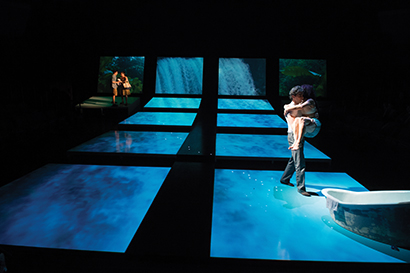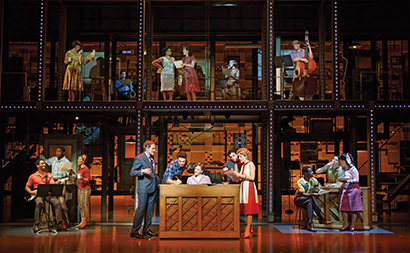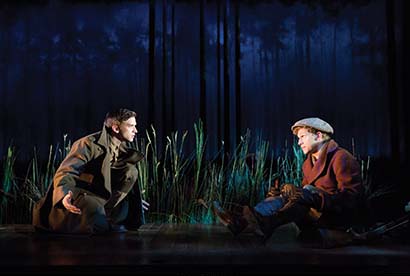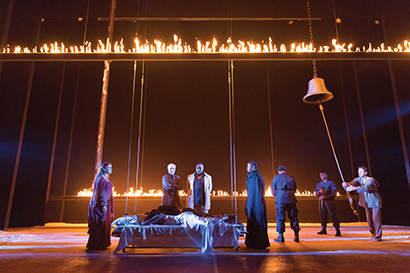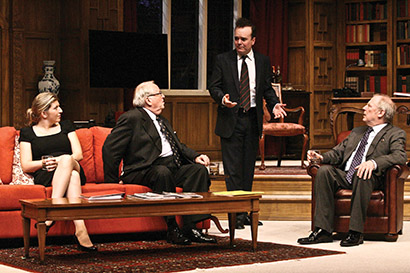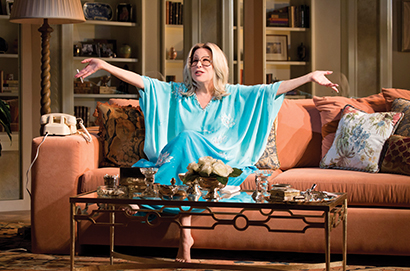A Bridge of Imagination
When you are doing a musical based on the bestselling book and hit film The Bridges of Madison County and cannot actually build a bridge onstage, that conundrum creates a seemingly insurmountable obstacle. But scenic designer Michael Yeargan tackled the problem with ingenuity, knowing that sometimes one can show someplace or something without fully representing it. He needed to figure out “how to depict a covered bridge on the stage when this action happens in it, through it, and behind it,” he says. “There was no way we could really build a covered bridge, so we designed it to indicate it with those arches that fly in.” It was a balancing act of scope and intimacy for a story centered on two people in love in an extramarital affair.
Creating a ‘Beautiful’ World
A Tale of Two Plays: Waiting for Godot and No Man’s Land
Tackling both scenic and costume design on a play is challenging enough, but when one is doing it for two productions in rep at the same theater, the stakes are raised substantially. Stephen Brimson Lewis took on those responsibilities in designing for the recent pairing of famed existential plays co-starring Ian McKellen and Patrick Stewart (Samuel Beckett’s Waiting For Godot and Harold Pinter’s No Man’s Land).
The Snow Geese: Inside Looking Out
Effects Heat Up Romeo & Juliet
Big Fish on Broadway
Big Fish is certainly one of the most eye-popping spectacles to hit Broadway in years. The stage adaptation of Daniel Wallace’s book, which was also turned into a film by director Tim Burton, is a vibrant musical that features high energy numbers, dozens of scene changes and some dazzling visuals in which scenic and projection design are integrated into a seamless blend. The story concerns Will Bloom (Bobby Steggert), a young husband and expectant father who is trying to discern the truth behind the tall tales frequently orated by his flamboyant father Edward Bloom (Norbert Leo Butz), a small town Alabama man whose health is in decline.
First Date: An Inside Out Approach to Musical Design
The new musical, First Date, offers a peppy pop spin on the awkward blind date that many of us have endured. Aaron (Zachary Levi) is a finance man with foot-in-mouth tendencies, and Casey (Krysta Rodriguez) is an artsy, edgy girl with a toxic sense of humor. As they trade quips, barbs and awkward pauses, they learn to understand each other and open up about their mixed pasts. Mirroring the show’s approach, media/scenic designer David Gallo sought to subvert traditional Broadway notions while working around them.
Pippin Power
When Tony Awards season arrives, theatre mavens are sometimes befuddled by certain choices that have been made and shows that have been slighted. But when PLSN caught Pippin after it opened this spring, it was obvious why it was nominated for, and won, a slew of those coveted accolades. Tony Award-winning director Diane Paulus has revived a 40-year old show and created a vibrant spectacle complete with athletic performers telling a tale of passionate soul searching and patricide under the alluring aura of a circus big top.
Simon Higlett’s Set Design for “Yes, Prime Minister” in Los Angeles
Many West End and Broadway designers are quite prolific, often working on more than one show at once. British scenic designer Simon Higlett likes to keep incredibly busy. As he spoke to PLSN from England, he was in the midst of simultaneously designing three shows at that very moment and seven in total for the time period. “I average about 15 or 16 a year,” he revealed, adding, with a touch of understatement, “I’m quite busy.” Higlett maintains a disciplined regimen to tackle this heavy workload. “I divide my time between morning, afternoon and evening and have quite strict rules,” he explained. “If it’s not done by the morning, I move onto the next one, and it kind of works until deadlines approach. It’s a slight juggling, but it’s not a problem really going from one to the other because they’re always so different. They don’t cross except when the deadlines get close together.”
The Fast and Furious Pace of Matilda
Anticipation for the opening of the hit British musical Matilda the Musical in New York ran high this past April. PLSN caught the show a few days after it officially opened, and there were two long lines snaking around the corner to get in. And the lavish musical did not disappoint. Inspired by the Roald Dahl book of the same name, it depicts the life of five year-old genius girl Matilda Wormwood, who must cope with a loud, boorish family and a repressive school environment that mock and deride her high level of intelligence, her creativity and her desire to learn more.
